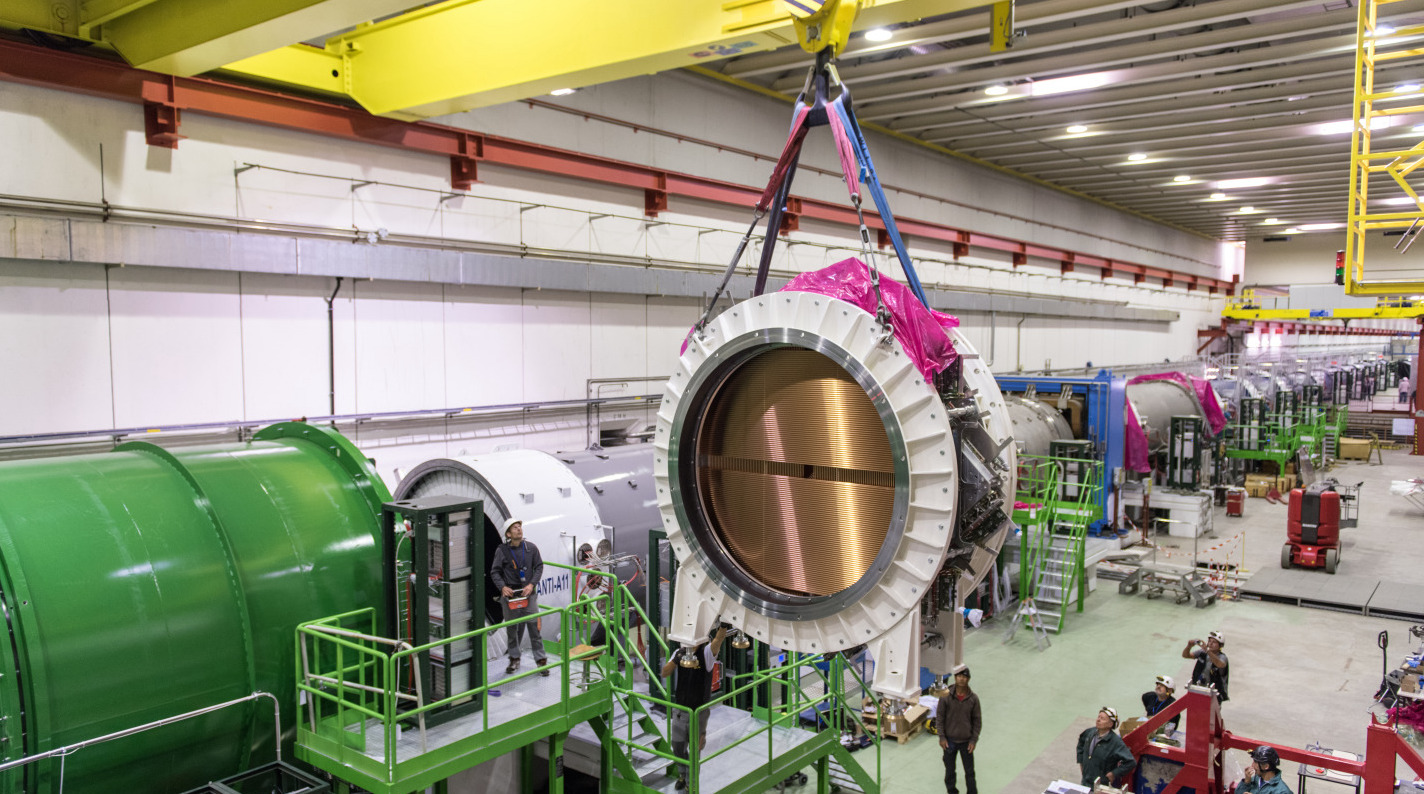
The NA62 experiment at CERN, in which groups from Italy's National Institute for Nuclear Physics (INFN) play a major role, has observed for the first time an extremely rare decay process that theoretical models predict with great precision. This new measurement, presented in a seminar at CERN on September 24, could open an important path toward the discovery of new physics beyond the Standard Model of elementary particles.
NA62 has observed the decay of a charged kaon into a charged pion and a neutrino-antineutrino pair. This decay is one of the rarest processes ever observed in the so-called flavor physics: according to the Standard Model, fewer than one in 10 billion charged kaons decay into these particles. NA62 measured the decay with a statistical significance of 5 sigma (5σ), meaning that the probability for the observed events to be due to random statistical fluctuations is 2x10-7.
"This result represents the culmination of a project started over a decade ago and is the result of a long and rigorous effort," said Giuseppe Ruggiero, researche at INFN and the University of Florence and spokesperson for the NA62 Collaboration. "Searching for processes in nature that have a probability of occurring on the order of 10-11 is fascinating and challenging, but also extremely demanding. With this measurement, we have delivered a highly anticipated result to the scientific community, which also represents a remarkable reward for our efforts".
Why do physicists search for such rare processes? Several theoretical models suggest that this decay is highly sensitive to deviations from the Standard Model prediction, making it one of the most interesting processes to study in the search for evidence of new physics beyond the Standard Model.
"NA62 was able to measure the frequency of this extremely rare decay relative to all possible decays of charged kaons. The measurement has a precision of 25%, making it the most precise measurement of this decay ever made. The result is intriguing, because the likelihood that the observed decay rate is due to a statistical fluctuation is just 5%. In physics, this means that the agreement with the Standard Model is reasonable, though not perfect," emphasized Renato Fiorenza, of INFN and the University of Naples Federico II, one of the leading analysts who contributed to the result.
"One possible reason for this discrepancy could be the presence of new particles that increase the decay probability, but more data is needed to test this hypothesis," explained Francesco Brizioli, of INFN Perugia, one of the two data analysis coordinators. "With the addition of the data currently being collected, in the coming years, NA62 may be able to confirm the existence of contributions to the decay from new physics or impose strong constraints on the magnitude of such contributions."
"Although finding evidence of new physics will require more data, this result represents a significant step forward and further strengthens the interest in these studies and the excitement about future results," explained Karim Massri, of Lancaster University, the NA62 physics coordinator.
The NA62 experiment was designed and built specifically to measure this extremely rare decay. The kaons are produced by a high-intensity proton beam from one of CERN’s accelerators, the Super Proton Synchrotron (SPS). This beam collides with a fixed target, producing a secondary beam of nearly 1 billion particles per second that is directed towards the NA62 detector. About 6% of these particles are charged kaons. NA62 precisely detects the kaon decay products, identifying and measuring all of the particles produced, except for the neutrinos, which appear as missing energy.
Data collected in 2021 and 2022 after a series of upgrades to the NA62 experimental apparatus, were crucial for the achievement of this result. The installation of new and enhanced detectors allowed the beam to operate at 30% higher intensity. These hardware upgrades, combined with improvements in the techniques used to analyze the data, allowed for a 50% more of the sought-after signal candidates to be collected in the same amount of time as in previous data taking.
The NA62 measurement relies on the ability to identify a single decay of interest for every 10 billion decays observed. Furthermore, the neutrinos in the decay cannot be detected, making it even harder to be certain that any particular event was truly the decay of interest, as opposed to one of the other 9,999,999,999 decays that could mimic the signal if some decay products go undetected or are misidentified.
“I am excited to have had the opportunity to present this important new result to the scientific community at CERN on behalf of the entire NA62 Collaboration,” commented Joel Swallow, of the INFN Frascati National Laboratories, one of the two data analysis coordinators.
"This important result was made possible thanks to the meticulous, precise analysis conducted by brilliant young researchers and PhD students from INFN. The Italian scientific community played a primary role in this difficult measurement," commented Antonella Antonelli, of the INFN Frascati National Laboratories of INFN, coordinator of the INFN groups participating in the NA62 experiment.
The NA62 collaboration involves about 200 researchers from Europe, the United States, Canada, Mexico, and Russia. The contribution of the Italian community, coordinated by INFN, stands out, with about a third NA62’s participants from INFN Frascati National Laboratories and the INFN divisions and universities of Ferrara, Florence, Naples, Perugia, Pisa, Rome Sapienza, Rome Tor Vergata, and Turin. INFN researchers have leading roles in both the construction and operation of the detector, in the development of the advanced beam tracking system, the photon and charged particle veto systems, and the pion identification system, as well as the experiment’s complex data acquisition system.






